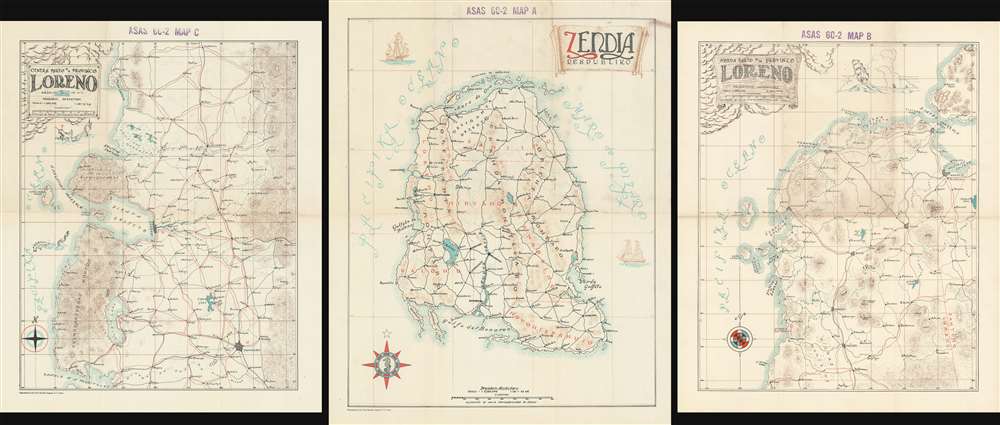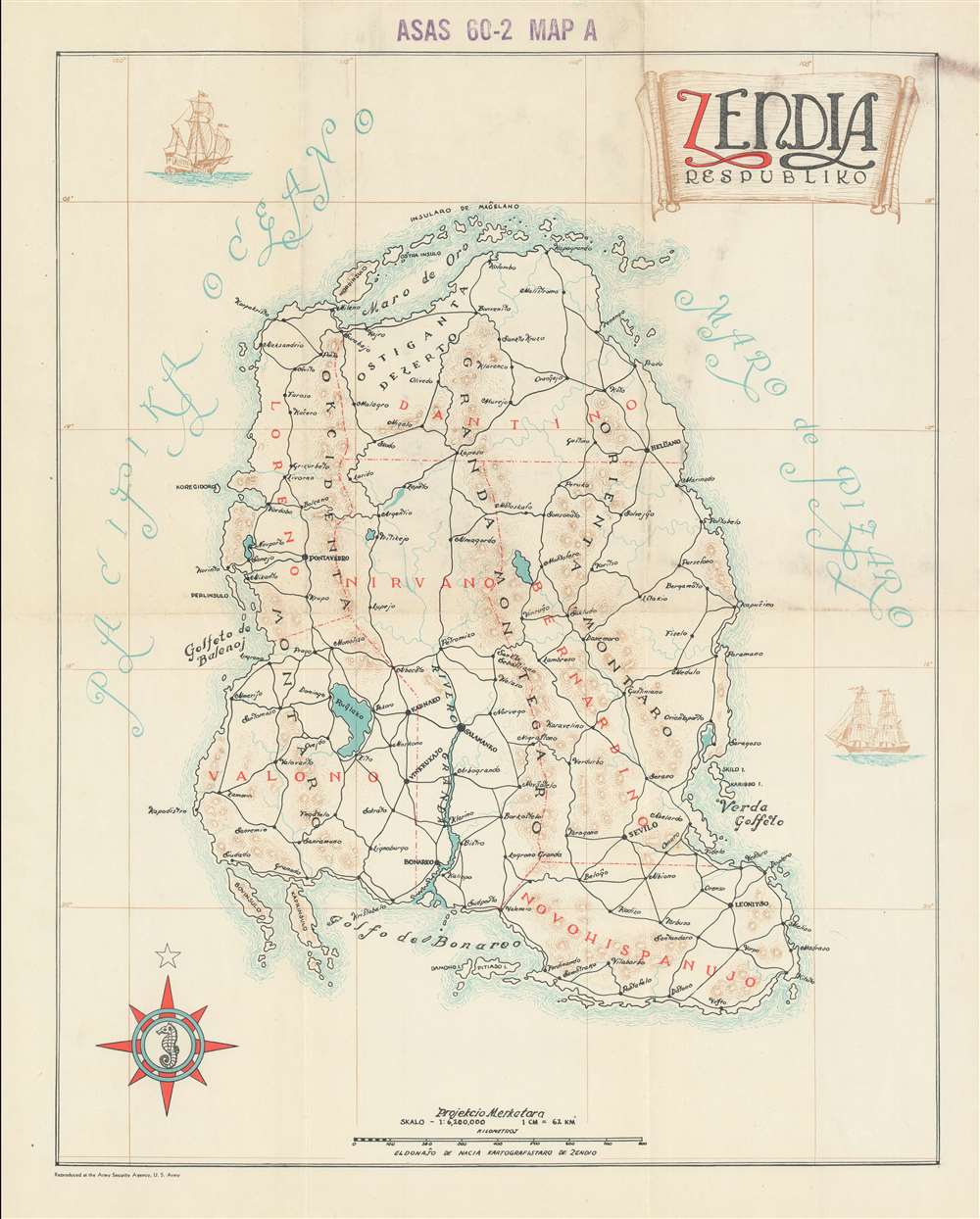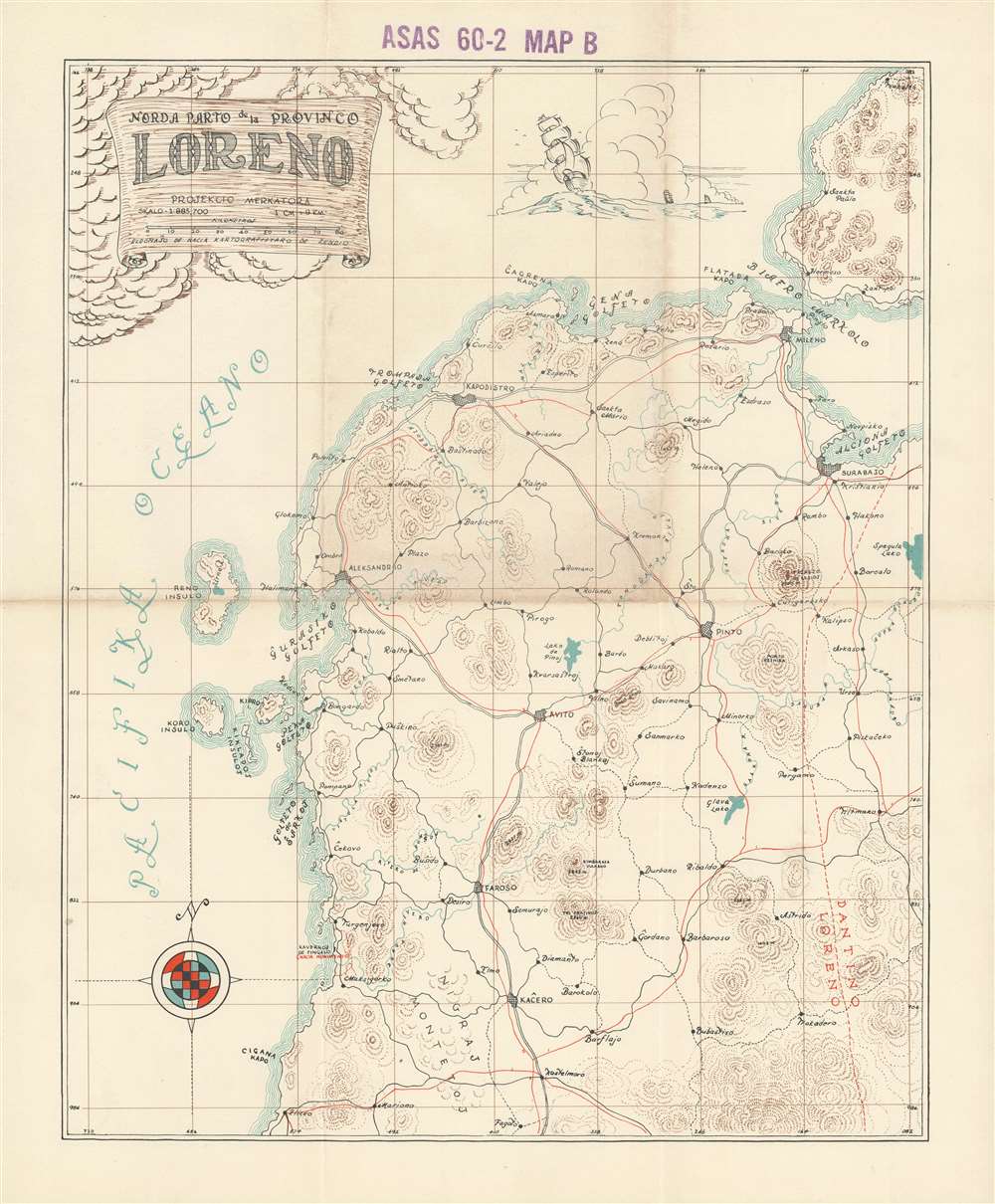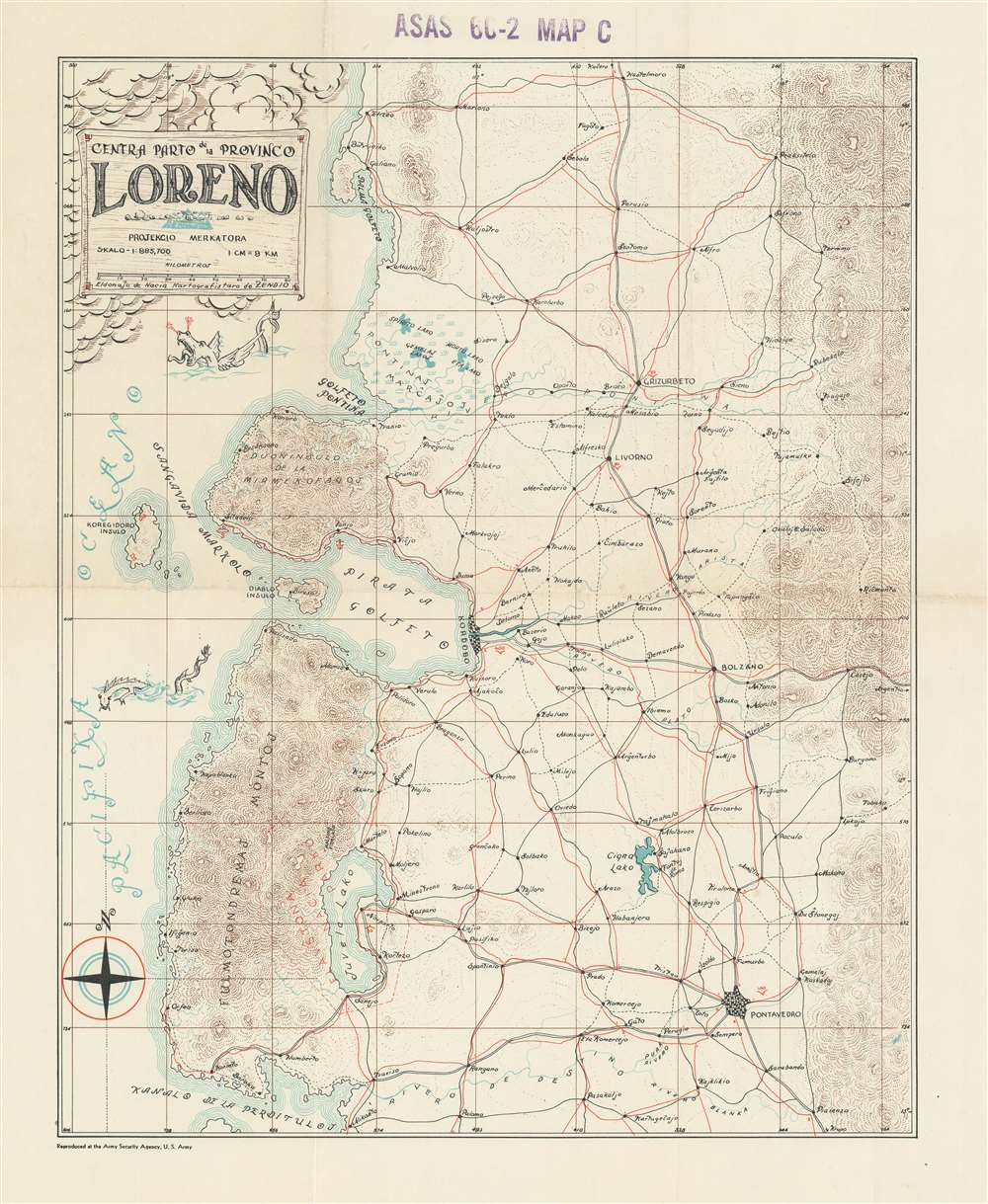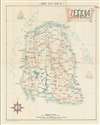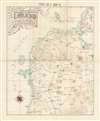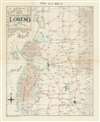This item has been sold, but you can get on the Waitlist to be notified if another example becomes available.
1960 Callimahos Top Secret Maps of the Republic of Zendia
ZendiaProblem-callimahos-1960
Title
1960 (undated) 20 x 15.5 in (50.8 x 39.37 cm) 1 : 6200000
Description
Historical Context: WWII, The Cold War, and Cryptanalitics
It is nothing short of astounding that when Callimahos walked into the army recruiting office in 1941 dressed as an operatic villain - complete with black top hat, black gloves, black cape, and white silk scarf - and announced that he would help the U.S. Government improve their cryptanalytics program - arguably the most arcane, opaque, and complex field of human endeavor - that they did not send him immediately to the front, but rather put him to work teaching military code-breakers. After World War II, the ensuing Cold War (1945 - 1991), a period of political tension between Soviet Union and the United States and their respective allies, the Eastern Bloc and the Western Bloc, brought Callimahos's cryptanalytic genius to the forefront. The tensions of the Cold War led to a global struggle involving secret agents, proxy wars, vast sums of government 'black money', and underground alliances propagated by a network of James Bond style operatives. Callimahos, now at work teaching NSA operatives how to intercept, decode, interpret, and act on cyphered military intelligence, was essential to this effort. He thus created the 'Aggressor' program in the 1950s, and in 1960, the Zendian Problem, illustrated here, a manifestation of the zeitgeist of his time.On the Maps
The three maps are printed in color, with topography in brown hachure, rivers, coastal waters and wetlands in blue, and with roads, cities and outlines in black. Other notations - presumably highways, indications of population magnitudes, and other features such as national parks are shown in red. All three maps are drawn according to the Mercator projection and U.S. Army mapping convention. Although the maps are quite modern in execution, they contain fanciful throwbacks; each features elegant cartouches and compass roses (that on the general map of Zendia is decorated with a seahorse). The general map (Map A) and the map of Northern Loreno (Map B) are embellished with ships; Map C of central Loreno has fierce sea monsters lurking outside the 'Sangavida Markolo.' Two of the three maps bear the imprint of the U. S. Army Security Agency, and all three bear the codes ASAS 60-2 maps A, B and C respectively. The text of all three maps is in Esperanto, and all three maps are credited to the Nacia Kartografistaro de Zendio, a body which we are quite certain has never existed, as Zendia and all of its provinces are imaginary.CA-400 and The Zendian Problem
These maps were pedagogical aides produced by the American cryptanalyst and educator Lambros D. Callimahos for his intensive top-secret NSA course, CA-400, a gauntlet through which twenty-two years' of the NSA's finest cryptanalysts passed, and only twelve participated per session. Each of the thirty-two eighteen-week sessions of CA-400 culminated with the dozen cryptanalysts wrestling with Callimahos' monumental 'Zendian Problem,' which the class's self-proclaimed 'Guru' and 'Caudillo' described in 1959:'The Zendian Problem', presenting an operational communication intelligence situation in miniature, affords opportunity to apply the techniques of traffic analysis and cryptanalysis, to derive intelligence, and to prepare reports. This problem deals with the enemy communication during a (fictitious) operation against Zendia, a totalitarian island state.Vincent William's article in the Winter 1979 issue of the NSA's Cryptologic Spectrum, says more:
Of all the course materials, the Zendian Problem is perhaps the best example of Callimahos's almost overwhelming thoroughness, as well as his creativity. His Zendia is no Lilliput or Brobdingnag, but a country of third or fourth world rank complete with a culture and a history - and a ruler, Salvo Salasio, whose portrait bears more than a passing resemblance to pictures of the young Callimahos. This small island nation was placed in the Pacifika Ocean by U. S. Army cartographers right where God forgot to put it. There are topographical maps and maps showing the distribution of industry and agriculture. There is also a more detailed map of the Loreno province, where most of the action takes place in this post-World War II war game.Many who completed the course went on to prestigious positions in both government and private industry and all, it seems, love Callimahos.
The problem includes a collection of 375 Zendian military messages (one day's intercept) enciphered in a variety of manual and machine systems. Students have the opportunity to reconstruct, from message preambles and the day's chatter, the Zendian 'Order of Battle'. They then attack the cipher messages, and within two weeks they diagnose and solve all the exploitable messages. This is an ideal opportunity for students to practice what they have learned in the course, and to organize and manage their own team's attack against the Zendian communications.
Why Esperanto?
Callimahos was, among his many facets, a linguist: he is thought to have spoken no fewer than nine languages, and could read more. Even if Esperanto were not familiar to him, given its similarity to the Romance languages, it would have not been opaque. But in this choice, he may simply have been following a convention established in the 1950s when he created the 'Aggressor' program. In the 1950s and 60s, the U.S. Army conducted elaborate live-action war games devised by Callimahos pitting American forces against an imaginary enemy named, conveniently, 'Aggressor'. Soldiers assigned to play the part of Aggressor troops had their own order of battle, armaments, uniforms, insignia and even carried fully detailed I.D. papers. They also had to speak a different language. So, apparently oblivious to the pungent irony, Callimahos chose Esperanto, which had been created in the 1880s to be the language of peace. While the Army's war games were executed in the field with the opposition speaking in halting Esperanto, the Zendian foe Callimahos concocted to baffle his hapless students was presented as speaking the same 'Aggressor' language. (Although it appears that the actual coded messages involved in the exercise were not also in Esperanto!). Others, as above, have noted that the 'Zendian Problem' may in fact be a training exercise for an invasion of Cuba, and thus Esperanto is a practical proxy for Spanish.In any case, Callimahos - whose sense of humor and wit was beloved, if not downright notorious among his students - uses the opportunity to have fun with language play. Map C features a 'Sangavida Markolo' leading to 'Pirata Golfeto' because after all, if you can invent your own island dictatorship, why not give it a Bloodthirsty Strait leading to Pirate Bay?
Zendia as 'The Isle of Pines'
Professor Charles Varga, in a 2017 paper published in Cryptologia argues convincingly that Zendia is in fact a proxy for the Isle of Pines, or Isla de la Juventud, Cuba. Zendia, he notes, is located off the coast of Chile, in the Pacific, but at roughly the same latitude, except south, as the Isle of Pines. Moreover, flipping the map of Zendia upside down yields a visual approximation of the Isle of Pines, both in terms of general morphology and internal landmarks. Further, as Varga, who has special access to Callimahos' notes via Callimahos's son Andrew, comments,… relative to the background of the Zendia Problem, it was devised as a training aid and tool for Spanish-speaking intercept operators as part of a traffic analysis exercise in Communications Intelligence Operations, monitoring radio traffic to determine the Order of Battle and to serve as a run up to an invasion of Cuba, by specially-trained independent Army forces, in order to establish a base of operations, then conceived as a government in exile, similar to a 'Two China' Formosa-Taiwan-Taipei political strategy.Castro, it is known, discovered via Soviet spies in Washington, the U.S. intention to establish an alternative 'Cuban' government in the Isle of Pines in a 'Taiwan to China' model. He subsequently reinforced the island, the second largest in Cuba, with landmines, tank and gunnery battalions, and a heavy infantry force, making it a practically unassailable fortress. (Marxist.org 1961). The White House, receiving intelligence regarding Castro's preparation on the Isles of Pines, determined to change the Zapada Plan, as it was called, and instead invaded the Bay of Pigs in 1961. The Zendian Problem, remaining a perfect pedagogical tool nonetheless, continued to be used in Callimahos's classes.
Publication History and Census
These three maps bear the imprint of the Army Security Agency, and the codes ASAS 60-2 maps A, B and C respectively. There are no examples in OCLC, and they are not dated. A document authored by Callimahos is noted in the National Cryptologic Museum library catalog, entitled 'Zendian Problem: Zendian Military Traffic Intercepted on 23 December.' This is dated July 1960 in the catalog. If we take this to be a printed version of Callimahos' course material for the Zendian Problem, it is reasonable to hazard that maps were printed concurrently. The 'ASAS 60-2' codes encourage this guess, as does the 'Vargas Theory' that Zendia was a proxy for the Isle of Pines and a planned 1961 invasion of Cuba. These maps have no history on the market and appear in no publicly accessible collections or catalogs. The exceptional rarity may simply be a factor of the fact that they were part of a 'top secret' program, likely not declassified until the early 2000s. A unique and extraordinary collection opportunity.Cartographer
Lambros Demetrios Callimahos (December 16, 1910 - October 28, 1977) was an American Renaissance man: teacher, writer, linguist, cryptologist, and flutist. Born in Alexandria of Greek parents, he emigrated to the United States at the age of four. He earned a law degree at Rutgers (under parental duress) but also trained at Juilliard, being awarded a degree in 1933. Starting in 1935 he toured professionally in Europe and the United States, heralded as Meisterfloetist. In 1936, he became the youngest professor at the Mozarteum Academy in Salzburg, Austria. He made his New York debut in 1937 at the Town Hall, and made musical history when he gave an all-flute recital at Carnegie Hall a year later. (His sense of humor, apparent later, seems to have manifested during his musical career - among his published sheet music: Theme and 78 Variations on 'Twinkle, Twinkle Little Star.’) Not constrained by either his education or his avocation, he was also an avid amateur cryptologist. With the advent of war in 1941, he joined the army in the hope that his interest in cryptology could be put to service: and so it was. He was put to work teaching Italian and cryptanalysis at Fort Monmouth. He found time to learn Japanese (he eventually could speak nine languages, and read several more) and would served as a Signals Intelligence officer in New Delhi. After World War II, he was assigned to the Army Security Agency as assistant to William F. Friedman, (the Dean of American Cryptology) and followed him to the NSA when that organization was formed in 1952. This was the beginning of Callimahos’ long tenure, teaching the NSA’s intensive-study cryptanalysis course CA-400, producing for that program an astonishingly deep array of support documents - especially for the part of this course known as the Zendian Problem which included an imaginary island nation replete with its own history, detailed maps, and a generalissimo bearing a striking resemblance to the flautist/educator/codebreaker as a young man. He taught 32 sessions of CA-400, to a grand total of 270 students. The graduates of the program - the elite of America’s cryptanalysts - were inducted into the Dundee Society (named after the empty Dundee marmalade jar Callimahos used as a pencil holder.) He would go on to revise Friedman's work to produce the textbook on Cold War codebreaking, ’Military Cryptanalytics.’ He was a prolific author publishing over 40 books and articles. He also established the NSA Technical Journal, serving as its technical advisor for the rest of his career.
He continued to play and perform flute during his entire career, and was known to practice in the CA-400 classroom as his cryptanalyst protégés studied. He continued to teach flute up until his death in 1977. More by this mapmaker...

